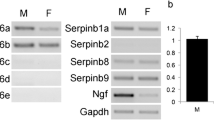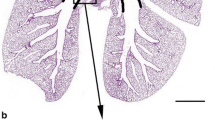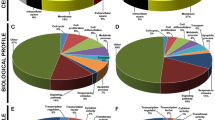Abstract
We recently described the Palate Lung Nasal Clone (PLUNC) family of proteins as an extended group of proteins expressed in the upper airways, nose and mouth. Little is known about these proteins, but they are secreted into the airway and nasal lining fluids and saliva where, due to their structural similarity with lipopolysaccharide-binding protein and bactericidal/permeability-increasing protein, they may play a role in the innate immune defence. We now describe the generation and characterisation of novel affinity-purified antibodies to SPLUNC2, and use them to determine the expression of this, the major salivary gland PLUNC. Western blotting showed that the antibodies identified a number of distinct protein bands in saliva, whilst immunohistochemical analysis demonstrated protein expression in serous cells of the major salivary glands and in the ductal lumens as well as in cells of minor mucosal glands. Antibodies directed against distinct epitopes of the protein yielded different staining patterns in both minor and major salivary glands. Using RT-PCR of tissues from the oral cavity, coupled with EST analysis, we showed that the gene undergoes alternative splicing using two 5′ non-coding exons, suggesting that the gene is regulated by alternative promoters. Comprehensive RACE analysis using salivary gland RNA as template failed to identify any additional exons. Analysis of saliva showed that SPLUNC2 is subject to N-glycosylation. Thus, our study shows that multiple SPLUNC2 isoforms are found in the oral cavity and suggest that these proteins may be differentially regulated in distinct tissues where they may function in the innate immune response.






Similar content being viewed by others
References
Ball WD, Mirels L, Hand AR (2003) Psp and Smgb: a model for developmental and functional regulation in the rat major salivary glands. Biochem Soc Trans 31:777–780
Bingle CD, Craven CJ (2002) PLUNC: a novel family of candidate host defence proteins expressed in the upper airways and nasopharynx. Hum Mol Genet 11:937–943
Bingle CD, Craven CJ (2004) Meet the relatives: a family of BPI and LBP-related proteins. Trends Immunol 25:53–55
Bingle CD, Gorr SU (2004) Host defence in oral and airway epithelia: chromosome 20 contributes a new protein family. Int J Biochem Cell Biol 36:2144–2152
Bingle CD, Vayarkarnam A (2008) Novel innate immune functions of the whey acidic protein family. Trends Immunol 29:444–453
Bingle CD, LeClair EE, Havard S, Bingle L, Gillingham P, Craven CJ (2004) Phylogenetic and evolutionary analysis of the PLUNC gene family. Protein Sci 13:422–430
Bingle L, Cross SS, High AS, Wallace WA, Devine DA, Havard S, Campos MA, Bingle CD (2005) SPLUNC1 (PLUNC) is expressed in glandular tissues of the respiratory tract and in cancers with a glandular phenotype. J Path 205:491–497
Bingle L, Cross SS, High AS, Wallace WA, Rassl D, Yuan G, Hellstrom I, Campos MA, Bingle CD (2006) WFDC2 (HE4): a potential role in the innate immunity of the oral cavity and respiratory tract and the development of adenocarcinomas of the lung. Respir Res 7:61
Campos MA, Abreu AR, Nlend MC, Cobas MA, Conner GE, Whitney PL (2004) Purification and characterization of PLUNC from human tracheobronchial secretions. Am J Respir Cell Mol Biol 30:184–192
Emes RD, Goodstadt L, Winter EE, Ponting CP (2003) Comparison of the genomes of human and mouse lays the foundation of genome zoology. Hum Mol Genet 12:701–709
Geetha C, Venkatesh SG, Dunn BH, Gorr SU (2003) Expression and anti-bacterial activity of human parotid secretory protein (PSP). Biochem Soc Trans 31:815–818
Geetha C, Venkatesh SG, Bingle L, Bingle CD, Gorr SU (2005) Design and validation of anti-inflammatory peptides from human parotid secretory protein. J Dent Res 84:149–153
Gorr SU, Sotsky JB, Shelar AP, Demuth DR (2008) Design of bacteria-agglutinating peptides derived from parotid secretory protein, a member of the bactericidal/permeability increasing-like protein family. Peptides 29:2118–2127
Guo T, Rudnick PA, Wang W, Lee CS, Devoe DL, Balgley BM (2006) Characterization of the human salivary proteome by capillary isoelectric focusing/nanoreversed-phase liquid chromatography coupled with ESI-tandem MS. J Proteome Res 5:1469–1478
Haigh B, Hood K, Broadhurst M, Medele S, Callaghan M, Smolenski G, Dines M, Wheeler T (2008) The bovine salivary proteins BSP30a and BSP30b are independently expressed BPI-like proteins with anti-Pseudomonas activity. Mol Immunol 45:1944–1951
Helmerhorst EJ, Oppenheim FG (2007) Saliva: a dynamic proteome. J Dent Res 86:680–693
Khovidhunkit W, Hachem JP, Medzihradszky KF, Duchateau PN, Shigenaga JK, Moser AH, Movsesyan I, Naya-Vigne J, Kane JP, Feingold KR, Grunfeld C (2005) Parotid secretory protein is an HDL-associated protein with anticandidal activity. Am J Physiol Regul Integr Comp Physiol 288:R1306–R1315
Madsen HO, Hjorth JP (1985) Molecular cloning of mouse PSP mRNA. Nucleic Acids Res 13:1–13
Mirels L, Ball WD (1992) Neonatal rat submandibular gland protein SMG-A and parotid secretory protein are alternatively regulated members of a salivary protein multigene family. J Biol Chem 267:2679–2687
Mirels L, Miranda AJ, Ball WD (1998) Characterization of the rat salivary-gland B1-immunoreactive proteins. Biochem J 330:437–444
Plummer C, Douglas CWI (2006) Relationship between the ability of oral streptococci to interact with platelet glycoprotein Ibα and with the salivary low-molecular weight mucin, MG2. FEMS Immunol Med Microbiol 48:390–399
Ramachandran P, Boontheung P, Xie Y, Sondej M, Wong DT, Loo JA (2006) Identification of N-linked glycoproteins in human saliva by glycoprotein capture and mass spectrometry. J Proteome Res 5:1493–1503
Robinson CP, Bounous DI, Alford CE, Nguyen KT, Nanni JM, Peck AB, Ammon B, Humphreys-Beher MG (1997) PSP expression in murine lacrimal glands and function as a bacteria-binding protein in exocrine secretions. Am J Physiol 272:G863–G871
Shaw P, Schibler U (1986) Structure and expression of the parotid secretory protein gene of mouse. J Mol Biol 192:567–576
Shiba H, Venkatesh SG, Gorr SU, Barbieri G, Kurihara H, Kinane DF (2005) Parotid secretory protein is expressed and inducible in human gingival keratinocytes. J Periodontal Res 40:153–157
Siqueira WL, Zhang W, Helmerhorst EJ, Gygi SP, Oppenheim FG (2007) Identification of protein components in vivo human acquired enamel pellicle using LC-ESI-MS/MS. J Proteome Res 6:2152–2160
Siqueira WL, Salih E, Wan DL, Helmerhorst EJ, Oppenheim FG (2008) Proteome of human minor salivary gland secretion. J Dent Res 87:445–450
Vargas PA, Speight PM, Bingle CD, Barrett AW, Bingle L (2008) Expression of PLUNC family members in benign and malignant salivary gland tumours. Oral Dis 14:613–619
Vitorino R, Lobo MJ, Ferrer-Correira AJ, Dubin JR, Tomer KB, Domingues PM, Amado FM (2004) Identification of human whole saliva protein components using proteomics. Proteomics 4:1109–1115
Walz A, Stuhler K, Wattenberg A, Hawranke E, Meyer HE, Schmalz G, Bluggel M, Ruhl S (2006) Proteome analysis of glandular parotid and submandibular–sublingual saliva in comparison to whole human saliva by two-dimensional gel electrophoresis. Proteomics 6:1631–1639
Weston WM, LeClair EE, Trzyna W, McHugh KM, Nugent P, Lafferty CM, Ma L, Tuan RS, Greene RM (1999) Differential display identification of plunc, a novel gene expressed in embryonic palate, nasal epithelium, and adult lung. J Biol Chem 274:13698–13703
Wheeler TT, Haigh BJ, McCracken JY, Wilkins RJ, Morris CA, Grigor MR (2002) The BSP30 salivary proteins from cattle, LUNX/PLUNC and von Ebner’s minor salivary gland protein are members of the PSP/LBP superfamily of proteins. Biochim Biophys Acta 1579:92–100
Wheeler TT, Hood KA, Maqbool N, McEwan JC, Bingle CD, Zhao S (2007) Expansion of the bactericidal/permeability increasing-like (BPI-like) protein locus in cattle. BMC Genomics 8:75
Acknowledgment
This work was funded by The Wellcome Trust and the Sheffield Hospital’s Charitable Trust.
Author information
Authors and Affiliations
Corresponding author
Rights and permissions
About this article
Cite this article
Bingle, L., Barnes, F.A., Lunn, H. et al. Characterisation and expression of SPLUNC2, the human orthologue of rodent parotid secretory protein. Histochem Cell Biol 132, 339–349 (2009). https://doi.org/10.1007/s00418-009-0610-4
Accepted:
Published:
Issue Date:
DOI: https://doi.org/10.1007/s00418-009-0610-4




